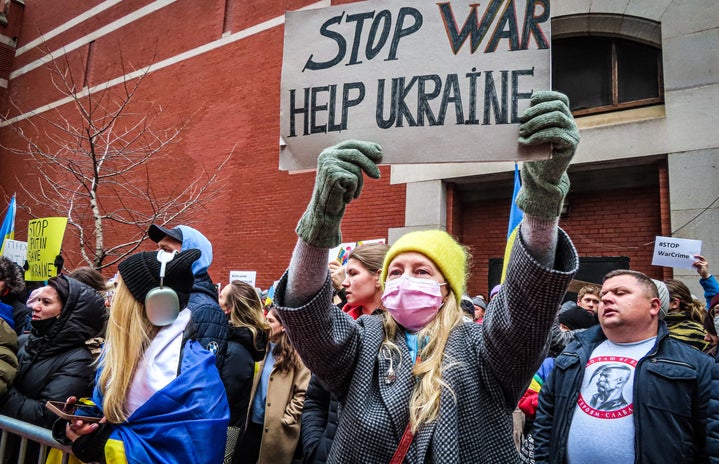Disclaimer: This piece was written on Feb. 27, 2022 and events are changing quickly and constantly. Please check your trusted national news source to stay up to date.
As Russia invades Ukraine at this moment, I feel the urge to do more than reload my web browser and wait for updates on Ukrainian soldiers and nuclear deterrence orders. If you want to understand the terrible situation between Ukraine and Russia that is currently shattering Europe on a historical scale, then here is what you need to know.
In the late 1700s, most of Ukraine’s territory became part of the Russian empire under Catherine the Great. In the early 20th century, Ukraine fought for independence, yet failed and became part of the Soviet Union. When the Soviet Union collapsed in 1990, Ukraine finally got the chance to declare its independence. Ukraine agreed to trade away the nuclear arsenal the Soviets had kept there in exchange for guarantees that the U.S., the U.K. and Russia would “respect the independence and sovereignty and the existing borders of Ukraine (according to the Budapest Memorandum, a compromise between the three countries signed in 1994).
In 2008, President Viktor Yanukovych and Prime Minister Yulia Tymoshenko of Ukraine attempted to bring Ukraine into the North Atlantic Treaty Organization (NATO). While U.S. President George W. Bush supported the membership, France and Germany opposed it after Russia voiced displeasure. In April of that year, NATO responded that Ukraine would one day become a member of the alliance, but never put a plan of action forward.
In 2009, following months of negotiations between Russia and Ukraine over gas prices, a Russian-owned gas company stopped pumping gas into Ukraine. This affected eastern and central European countries as they relied on the gas pipelines that ran through Ukraine. This put international pressure on Ukraine’s shoulders to make peace with Russia. Tymoshenko negotiated with President Vladimir Putin of Russia, and gas flow finally resumed on Jan. 20, 2009.
After Yanukovych was reelected in 2010, Ukrainian prosecutors opened criminal investigations into Tymoshenko, alleging misuse of government resources. In October of 2011, they found her guilty of “abuse of power” during the 2009 gas price negotiations. A few years later, Yanukovych refused to sign an agreement with the European Union (EU) to bring Ukraine into a free trade agreement. This sparked huge protests across Ukraine, calling for Yanukovych to resign. Yanukovych fled before a scheduled impeachment in February of 2014, and an interim government was installed. Putin declared that the change in government was an illegal coup and sent Russian soldiers to the Crimean Peninsula.
Now the Crimean Peninsula has been a land of heated fighting ever since 2014. Putin claimed in 2014 that Russia was seizing Crimea from Ukraine because Crimea is composed of mostly ethnic Russians. Therefore, he justified the aggression by allowing the people of Crimea to “be able to freely express their will.” When violence broke out due to Russians seizing the eastern Ukrainian region of Donbas, Russia denied that its troops were on Ukraine soil–Ukrainian officials insisted otherwise.
To this day, the fighting in Donbas has not ceased and public sentiment in Ukraine has been pushed toward the West, strengthening the interest to join NATO. In 2016 and 2017, the fighting in Donbas continued with Russia repeatedly striking Ukraine in cyberattacks. In fact, one attack caused Kiev’s power grid to black out. Cyberattacks have continued to this day with the latest being a major attack targeting government websites.
In August of 2021, Volodymyr Zelenskyy, elected president of Ukraine since 2019, visited the White House to meet with President Joe Biden. During a press conference, Biden emphasized that the U.S. is committed to Ukraine’s sovereignty, but followed up with a statement about how Ukraine does not yet have the conditions necessary to join NATO.
In January of 2022, the U.S. ordered 8,500 troops to be ready to be deployed. In February, Biden ordered 2,000 troops to be deployed to Poland and Germany. In the meantime, Russia continued to build its troops at the Ukrainian border, now estimating between 150,000 to 190,000 troops. Many U.S. officials increased warnings to U.S. citizens that Russia has decided to invade. Finally, on February 21, Putin deployed troops to territories controlled by Ukrainian armed forces. This prompted Biden to finally declare “the beginning of the Russian invasion.”
Three days ago, Russia forced an assault on Ukrainian territory on a scale not seen since the end of World War II.
Now, it is not possible for people to leave their homes. Kyiv is on lockdown because any person outside will be regarded as an enemy and will be shot. Putin has ordered its nuclear deterrent forces to be on “high alert.” There are 50,000 casualties so far and 1.5 million displaced persons. As the minutes go on, the situation becomes increasingly dire.

